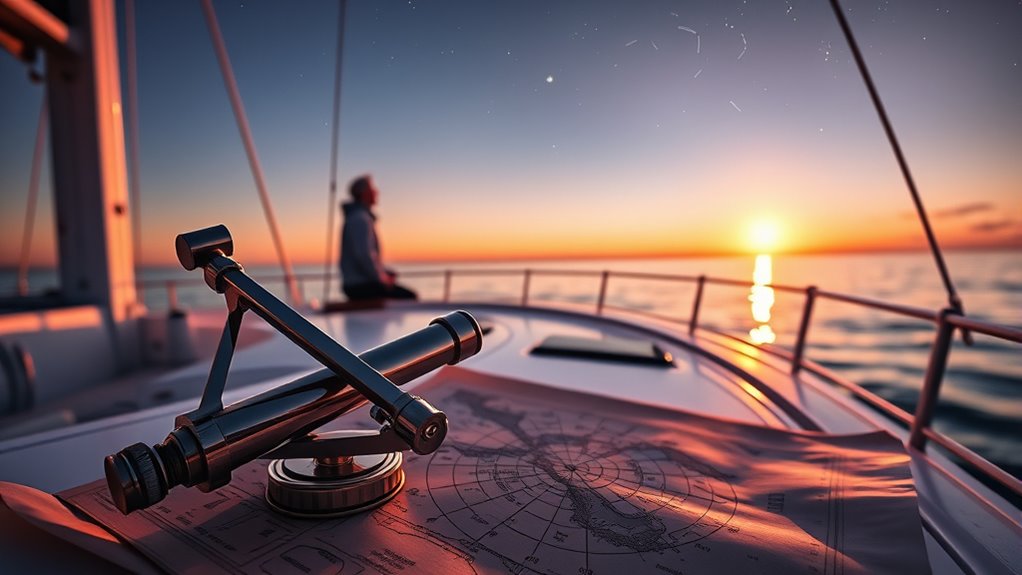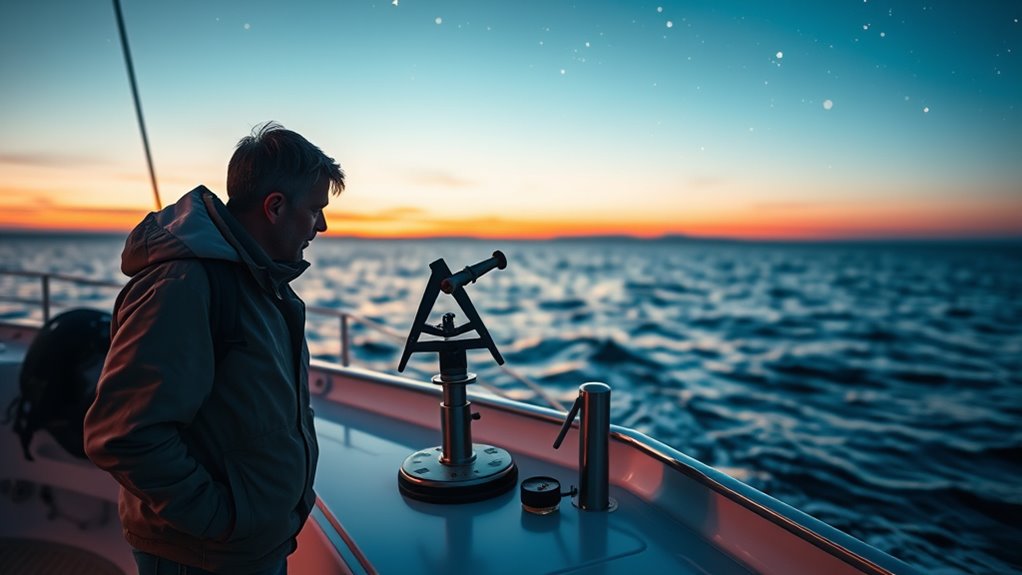Celestial navigation is a essential skill for modern sailors, helping you connect with maritime tradition while enhancing your sailing experience. By using a sextant to track stars and the sun, you can navigate confidently even when technology fails. Understanding celestial movements allows you to anticipate weather and tides, enriching your connection to the ocean. Embracing this ancient art not only boosts your skills but also deepens your relationship with the universe—explore more about its benefits.
Key Takeaways
- Celestial navigation connects modern sailors to maritime traditions, enhancing their understanding of navigation beyond electronic devices.
- Using tools like sextants, sailors can determine their position by observing stars and celestial bodies, ensuring reliable navigation.
- GPS and electronic devices can fail; celestial navigation serves as a dependable backup method for independent navigation.
- Understanding celestial movements helps sailors anticipate weather patterns and gain a sense of place in the vast ocean.
- Mastering celestial navigation boosts sailors’ confidence, fostering a deeper connection to their environment and maritime history.

Although technology has transformed guidance with GPS and digital charts, many modern sailors still find value in celestial navigation. You might wonder why you’d bother with traditional methods when you have a smartphone in your pocket. The answer lies in the skill and confidence that come from understanding the stars and their movements. When you engage in star tracking and navigational astronomy, you connect with centuries of maritime tradition, gaining insights that technology can’t always provide.
Imagine you’re out on the open water, the sky darkening as night falls. Instead of relying solely on your electronic devices, you pull out a sextant and search for the North Star, Polaris. Knowing how to find it not only helps you determine your latitude but also gives you a sense of place in the vast expanse of the ocean. As you track celestial bodies, you develop a deeper relationship with your surroundings. The stars become your companions, guiding you through the night.
Pull out your sextant and connect with the stars; they’ll guide you through the night and deepen your sailing experience.
While GPS is incredibly accurate, it’s not infallible. Satellite signals can fail, devices can malfunction, or batteries can die. In these moments, your knowledge of celestial navigation becomes invaluable. You might find yourself using the sun during the day and stars at night to plot your course. By learning the basics of navigational astronomy, you’ll gain the ability to navigate even when technology lets you down.
Understanding the movement of celestial bodies helps you anticipate weather patterns and tides, making you a more effective sailor. You’ll realize that the sun rises and sets in predictable patterns, providing guidance information about your position. When you start tracking stars and planets, it’s not just about guiding; it’s about experiencing a connection to the universe that modern tools sometimes obscure. Additionally, mastering celestial navigation enhances your overall image quality as a sailor, allowing you to navigate with confidence.
You might think that celestial navigation is a skill for the past, but in reality, it’s a practical and enriching experience for any sailor. It enhances your sailing skills and builds confidence in your ability to guide without relying solely on technology. So, next time you’re out on the water, take a moment to look up at the stars. Embrace the challenge, and you’ll find that celestial navigation can be both a useful skill and an incredible adventure.
Frequently Asked Questions
What Tools Do I Need for Celestial Navigation?
You’ll need a few essential tools for celestial navigation. Start with a sextant, which helps measure angles between celestial bodies and the horizon—make sure it’s properly calibrated. A reliable nautical almanac is vital too, providing data on celestial bodies’ positions. You might also want a compass, a chronometer for accurate timekeeping, and a good set of charts. Familiarizing yourself with historical methods can enhance your understanding and skills in this timeless practice.
How Does Celestial Navigation Differ From GPS?
Celestial navigation relies on the position of stars and celestial bodies, while GPS uses satellite signals to provide location data. You’ll find that celestial methods often offer historical accuracy, connecting you to centuries of maritime tradition. However, GPS, though convenient, has an environmental impact due to the technology’s energy consumption and reliance on satellites. Choosing between them can depend on your values regarding tradition, accuracy, and environmental considerations.
Can I Learn Celestial Navigation Online?
Yes, you can learn celestial navigation online! Many resources are available, including courses and tutorials that cover historical techniques. You’ll study celestial charts and understand how to use them effectively. Online platforms often provide interactive tools, videos, and forums where you can ask questions and connect with others. By dedicating time to these resources, you’ll gain the skills needed to navigate using the stars, enhancing your sailing experience.
What Are Common Mistakes in Celestial Navigation?
When you commence the journey of celestial navigation, think of it as sailing a ship through a sea of stars. Common mistakes often arise from neglecting error correction and misunderstanding historical techniques. You might misidentify celestial bodies or miscalculate angles, leading to navigational discrepancies. Overlooking time zone adjustments can also steer you off course. Embrace these lessons, and you’ll navigate more confidently, turning potential pitfalls into stepping stones for success.
How Long Does It Take to Master Celestial Navigation?
It typically takes several months to master celestial guidance, but it really depends on your dedication. You’ll need practice consistency to build your skills effectively. Regularly orienting yourself and using mental calculations will help reinforce what you learn. Don’t rush the process; embrace each step and challenge. With enough time and effort, you’ll gain confidence and become proficient in guiding the stars, making it a rewarding experience for you.
Conclusion
As you chart your course through the vast ocean, remember that celestial navigation is your guiding star, much like Odysseus steering the treacherous seas. Embrace the ancient wisdom of the stars, allowing their light to illuminate your journey. With each adjustment to your sails and every sighting of the heavens, you’ll find a sense of adventure and connection to those who’ve sailed before you. Trust in the cosmos, and let it steer you toward your destination.










